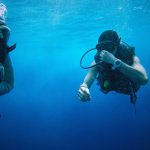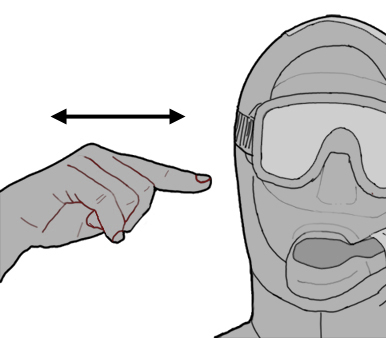 Ever find yourself underwater hovering just above the water line or you’re hanging onto a dive rope watching other divers gently and gracefully descend. Meanwhile you’re feeling this annoying pressure or maybe even pain in one or both of your ears…
Ever find yourself underwater hovering just above the water line or you’re hanging onto a dive rope watching other divers gently and gracefully descend. Meanwhile you’re feeling this annoying pressure or maybe even pain in one or both of your ears…
You begin doing this crazing head dance of rotating your head from side to side, moving your jaw from side to side, pretending you’re yawning and ascending and descending… repeat, repeat… all this to equalize your ears when diving!!
Finally, you hear your ears pop and when it pops… i think of it as a tiny little squeal and you instantly get this ahhh feeling and everything is good and now you slowly descend and join the rest of the dive group who have been so patiently waiting for you.
Diving with ear grief is one the biggest reasons why new divers quit diving in my opinion!
Ever heard of the term ‘equalizing your ears’?
Equalizing your ears also known as ear clearing means taking maneuvers or actions that require some sort of skill and care to equalize the pressure in your middle ear to that of your outside pressure (water pressure).
The middle ear which has dead air space may sometimes have less pressure than the outside pressure. It’s also attached to the Eustachian tube which looks after our equilibrium. When you dive, that Eustachian tube can sometimes collapse due to water pressure. This is when we start to feel some pain and discomfort in our ears.
If you’re not a diver, you can relate to this as being on an airplane and you feel some pressure, discomfort, even pain in your ears when it makes a fast descent. Even freedivers and skydivers can experience this. You try yawning and moving your jaw from side to side too…
What happens if you don’t equalize your ears underwater?
When the pressure in your middle ear is not equal to that of the outside pressure and left unattended underwater… severe complications can occur!! Here’s what can happen…
1) You can burst your eardrum. When this happens, you’ve already damaged your hearing. You will experience vertigo as a result of your middle ear filling up with cold water, which then chills your inner ear. L
2) You can cause damage to your other body part air spaces like your sinuses under your eyes, between your eyes, above your eyes and behind your eyes.
If either or both complications occur, you need to let your buddy and guide know and then you both abort your dives.
Communicate ear problem with your dive buddy and tour guide!
When you first dive underwater and start equalizing your ears… this is when you will know if you’re having ear clearing challenges. Your dive buddy is there with you close by and your dive tour guide may be just ahead of you leading the other divers. You need to communicate with your dive buddy and point to your ear and when the tour guide (usually an Instructor) turns around to check on you you should also let the guide know you are working on your ears! This way, the guide can slow the other divers and also keep an eye on you.

Author: Mikkelbg
Best Methods to Equalize Your Ears
It’s all about opening your Eustachian Tubes underwater!!
Just so you know, you will learn the basic skills of how to equalize or clear your ears underwater when you take either the Discover Scuba or the Open Water Dive Course.
You will however, soon learn once you start doing more dives in the beginning, even the basic skill of the Valsalva Maneuver (see below) may not be enough. I usually find I need to use additional methods just to equalize my ears…
I have put together a list of techniques I often hear from other divers that work best for them as well as to what always works for me.
1) Start Early! This is important… Before you even enter the water, you want to start the practise of equalizing your ears a few hours ahead. One of the ways is to simply do some swallowing. Chewing gum is helpful as well and you can also do this between your dives. If you hear both your ears pop that’s a great sign your Eustachian tubes are open and clear.
But.. this does not mean, you can stop equalizing your ears when you’re underwater!!
2) Ask Your Dive Tour Guide if there’s a descent line…
I enjoy diving with small dive boats because they usually have a diver’s rope (descent line) at the back of the boat. The diver holds onto the rope to slowly descend. While holding the rope, descend slowly feet first about 2 feet at a time, stop and pinch your nose and very gently blow quickly through your nose (Valsalva Maneuver). Repeat the procedure until your ears pop.
If you start to feel discomfort or pain in your ears, stop descending. Slowly ascend up about a foot, and try again. Repeat the process until you’re ready to release the rope.
The idea is to start early in the water even before you start feeling pressure in your ears.
No descent line? Bigger dive boats usually don’t have a descent rope and this is perfectly ok. You need to focus more on controlling your descent.
Without a descent line to hold on to and control your descent, you risk the chance of going down too fast and suffering barotrauma. One of the symptoms may be nosebleeds and you won’t know this until you surface and another diver brings it to your attention. You may also experience temporary hearing loss. For most people, the condition is generally not harmful but you still need to know the difference from acute and chronic … so you know when to get medical help.
If there is no descent line at the back, you can always swim to the anchor or mooring line to help control your descent.
3) Valsalva Maneuver.
When you’re diving, you breathe thru a regulator. For this procedure to work you only need to pinch your nose but don’t block it and moderately attempt to exhale out thru the nose while still breathing normally. This should take no longer than 2 seconds at the most. Repeat procedure as often as needed. This procedure opens your Eustachian tubes. It’s the basic skill you learn in your Discover Scuba and Open Water Dive Certification Course.
This method is quite effective… I use this procedure first and if that doesn’t work I try other methods mentioned here.
Caution: Don’t be overly forceful when blowing through your nose. Pinching your nose while blowing increases your internal fluid pressure in addition to the fluid pressure in your inner ear. You want to be careful not to damage your inner ear.
4) Always Descend Feet First!
Not descending feet first is more challenging to clear your ears because of the natural process of the mucus draining downward and the air needs to travel up your Eustachian tubes. Some divers can clear their ears very easily diving head first because they do lots of dives. Others can’t do a rapid descent this way and cannot clear their ears successfully.
Regardless, the most important thing to do is to equalize early.
The procedure here, descend slowly feet first, don’t worry about the rest of the divers if they’re ahead of you, they’ll wait. When you feel pain in your ears, stop descending and equalize your ears before you go down further.
By the way, did you know that the more dives you do the better your eustachian tubes will open and become easier to clear? This is absolutely TRUE.. so get out there and do more dives!!
5) Eliminate tight dive hood.
Do not wear a tight dive hood that completely blocks the air over your outside ear hole. Also never ever wear ear plugs. You’ll be fine descending and diving because your eustachian tubes may temporarily clear by force when you use the Valsalva Maneuver… however, once you ascend you may get what’s called a ‘reverse block’. This is caused by a blockage in your middle ear because the air can’t escape. Your eardrum will burst outwards and again cold water rushes into the middle ear… and now you get the same end result like that of a burst eardrum. This messes you on your balance because you’re experiencing vertigo! Not fun… immediately let your dive buddy know and slowly ascend… abort the dive!
Caution: If you have a common cold and your head feels ‘stuffed’ up, it’s best not to dive because you risk causing a reverse block.
6) Try Yawning.
This might be a little challenging but try yawning being careful not to open your mouth too wide which could cause the release of the regulator from your mouth.
This procedure opens your eustachian tubes.
I also do this on the airplane to clear my ears!!
7) Swallowing.
Ever noticed anytime you swallow your ears pop? Go on… give it a try! This method really works to open up your Eustachian tubes.
8) Toynbee Maneuver.
This is a combination of pinching your nose and swallowing. So when you pinch your nose, it squeezes the air that goes through to the middle ear. The swallowing opens the eustachian tubes because of the movement of your tongue. This works wonders too.. Try it now!!
9) Look up.
Keeping your head up opens your eustachian tubes because you’re extending your neck.
10) Keep practicing!
The more you practice the easier it is to… It’s quite normal to use more than 1 technique.
What’s next?
This is it folks and I hope you enjoyed reading my article! If you have had experiences in ear challenges or have had no problems… either way, I really would like to hear from you. I would like to know what methods work for you and what does not work.
Hey, do you want to know how to communicate underwater? Check out my underwater hand signals for divers!

Hello there,
You are actually absolutely right! I am a diver myself and when I started diving I had some issues with equalising the pressure in my ears. If only I had this article back then haha… But yeah, I can say it as well – My main problem was that I was diving with my head downwards, and like you explained that really makes equalising very hard. I was trying to release the pressure and it just didn’t work. Then I went in a horizontal position with my head up and it stabilised right away.
I presume you’re a diver yourself as well? What was the maximum depth you went to?
Hi Dejan,
Thank you for your comment! Wonderful to meet another diver!
Yes, sometimes we’re too excited about getting down underwater and just dive head first. Then we realize what we did wrong because we start feeling that pressure… I did that myself and like you went into horizontal position with my head up… what a relief!!
My deepest dive was 120’… definitely not much to see! I prefer the 20-40′ … so much more to see but the deep dive was exhilarating too!
Have you been to Turks & Caicos? Beautiful wall diving..
Thanks again!
Monica
Hey again,
That’s 120 feet right? We have the metric system here haha. And yeah I agree, you’ll find sea life 10-20 meters below the surface. My maximum depth was 40 meters, there isn’t much point going further, to be honest.
I’ve never been to any exotic country and it’s one of my wishes to once go there.
Dejan
Hey Dejan,
Thanks for getting back to me. Wow… 40 meters! Would be nice to try that…I work with metric also but still think mostly in feet. Yes… 120 feet.
If you do decide to go diving to Turks & Caicos, go to Grand Turk. Great wall diving.. drops to 7000 feet. Lots to see and if you go between January and March you’ll see and hear humpback whales passing through.
Best,
Monica